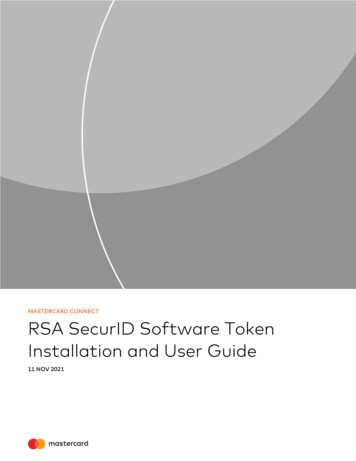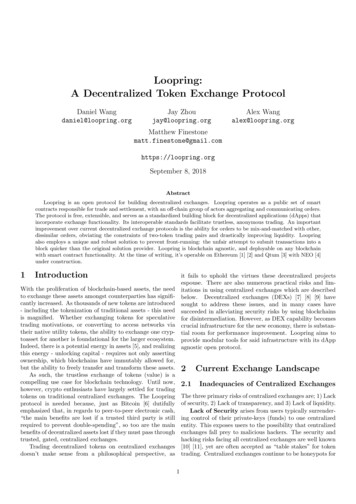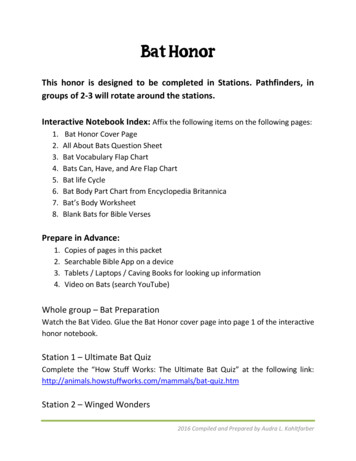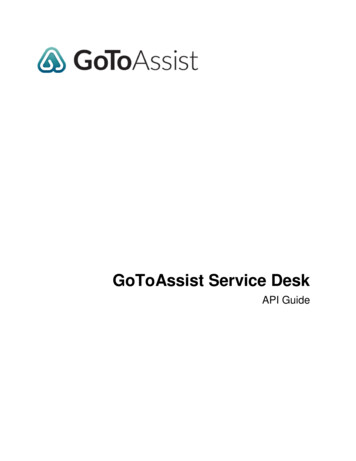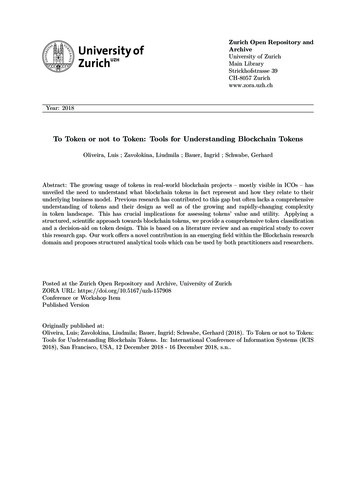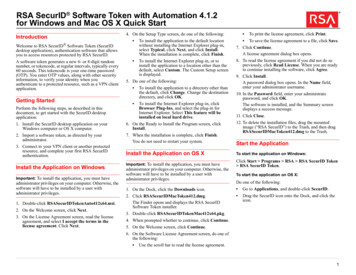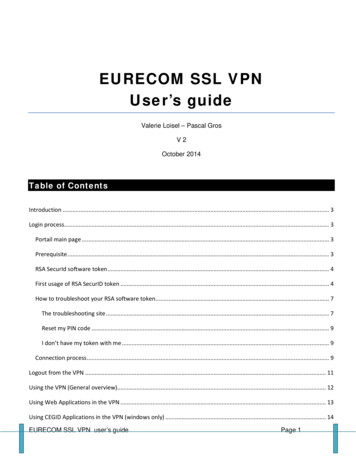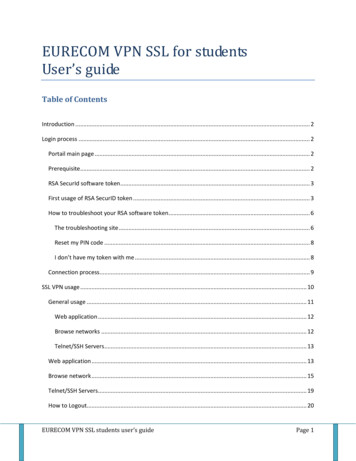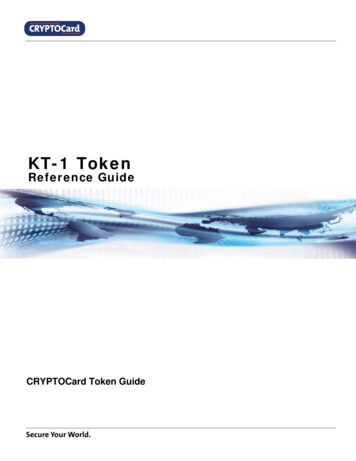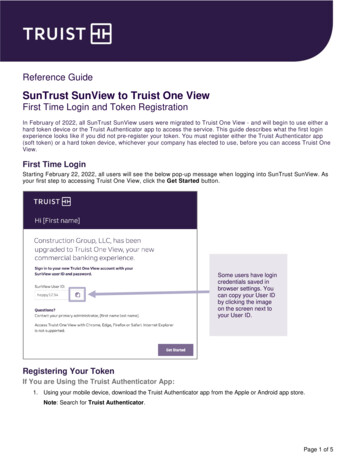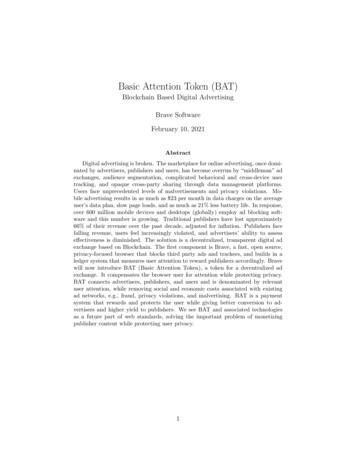
Transcription
Basic Attention Token (BAT)Blockchain Based Digital AdvertisingBrave SoftwareFebruary 10, 2021AbstractDigital advertising is broken. The marketplace for online advertising, once dominated by advertisers, publishers and users, has become overrun by “middleman” adexchanges, audience segmentation, complicated behavioral and cross-device usertracking, and opaque cross-party sharing through data management platforms.Users face unprecedented levels of malvertisements and privacy violations. Mobile advertising results in as much as 23 per month in data charges on the averageuser’s data plan, slow page loads, and as much as 21% less battery life. In response,over 600 million mobile devices and desktops (globally) employ ad blocking software and this number is growing. Traditional publishers have lost approximately66% of their revenue over the past decade, adjusted for inflation. Publishers facefalling revenue, users feel increasingly violated, and advertisers’ ability to assesseffectiveness is diminished. The solution is a decentralized, transparent digital adexchange based on Blockchain. The first component is Brave, a fast, open source,privacy-focused browser that blocks third party ads and trackers, and builds in aledger system that measures user attention to reward publishers accordingly. Bravewill now introduce BAT (Basic Attention Token), a token for a decentralized adexchange. It compensates the browser user for attention while protecting privacy.BAT connects advertisers, publishers, and users and is denominated by relevantuser attention, while removing social and economic costs associated with existingad networks, e.g., fraud, privacy violations, and malvertising. BAT is a paymentsystem that rewards and protects the user while giving better conversion to advertisers and higher yield to publishers. We see BAT and associated technologiesas a future part of web standards, solving the important problem of monetizingpublisher content while protecting user privacy.1
Contents1 Value Proposition32 Introduction2.1 An Inefficient and Troubled Market . . . . . . . . . . . . . . . . . . . . .2.2 The Attention Marketplace: . . . . . . . . . . . . . . . . . . . . . . . . .3343 A New Deal: Attention-based Economics3.1 Basic Attention Metrics (BAM) . . . . . .3.2 Token Technology . . . . . . . . . . . . .3.3 Tokens Used as Publisher Payment . . . .3.4 Tokens for User Applications . . . . . . .3.5 Roadmap . . . . . . . . . . . . . . . . . .on. . . . . .Blockchain. . . . . . . . . . . . . . . . . . . . . . . . . . . . . . . . . . . .1213141617184 Business landscape4.1 Competition . . . . . . .4.2 BAT Advantage Matrix4.3 BAT Overview . . . . .4.4 Key Team Members . .18181919215 Token Launch5.1 Token Launch summary5.2 Token Distribution . . .5.3 User Growth Pool . . .5.4 Budget Allocation . . .22222222236 BAT FAQs247 Appendix7.1 A More Efficient Market: Coase Theorem . . . . . . . . . . . . . . . . .7.2 A Three-Way Coasean Bargain . . . . . . . . . . . . . . . . . . . . . . .7.3 An Analysis of the Stability of the BAT . . . . . . . . . . . . . . . . . .262629322
1Value PropositionWe propose the BAT as a token of exchange in a secure, anonymous, opt-in advertisingsystem based in the browser and the mobile app webview. The BAT system provides: Users: strong privacy and security when viewing advertisements, improved relevance and performance, and a share of tokens. Publishers: improved revenue, better reporting, and less fraud. Advertisers: less expensive customer attention, less fraud, and better attribution.2Introduction“Attention has been widely recognized as a commodity, like wheat, pork belliesor crude oil. Existing industries have long depended on it to drive sales. Andthe new industries of the twentieth century turned it into a form of currencythey could mint. Beginning with radio, each new medium would attain itscommercial viability through the resale of what attention it could capture inexchange for its ’free’ content.” -Tim Wu, Attention BrokersThe promise of advertising technology (“ad-tech”) was to create a more efficientmarketplace for attention. The hope was that the Internet, the latest kind of “newmedium,” would arrive with a transparent and efficient ad marketplace.In theory, excellence would be rewarded. The best journalism and entertainmentwould receive the attention and funding it deserved. Ad tech would “get marketerscloser to their users via data analysis, immediate valuation and distribution.” Datawould be used to “accurately identify audiences, determine the value of those audiences,and deliver the right messages to them instantly.”[1] In short, users’ attention would bevalued properly.That didn’t happen. Instead, the ad-tech ecosystem that has evolved over the lasttwo decades is a bewildering variety of middlemen and complexity. Worse, ad-techintroduced a host of correlated problems for publishers, advertisers and users. Usershave lost their privacy, face increasing malware, pay high charges to download ads, andsuffer slow speeds. Publishers have lost billions in revenue while fraud has skyrocketed.And advertisers face poor reporting and targeting.This paper will review the current state of ad-tech and the predicament of content producers. It will outline a new solution that creates a transparent and efficientBlockchain-based marketplace for publishers, advertisers and users, accurately valuingand rewarding the key driver of Internet content: durable user attention.2.1An Inefficient and Troubled MarketThomas Davenport and JC Beck note that “attention is focused mental engagementon a particular item of information. Items come into our awareness, we attend to a3
particular item, and then we decide whether to act.”[2] Attention is, in this sense, aform of scarcity, which raises fundamental economic questions, which we shall addressmomentarily.Advertising, throughout history, has been used as the primary mechanism to captureAttention, raise it to a level of Interest to incite some Desire that can then translateit into Action – otherwise known as AIDA.[3] The earliest forms of advertising dateto ancient China, Egypt and the Middle Ages in Europe. The print form of advertising began to expand widely with the growth of 19th Century printed products. Thismarketplace of advertisers, publishers and users remained relatively straightforward –despite some additions – even as the new media of radio and television arose.The rise of the Internet brought the development of a new level of advertising technology with the promise of higher speed and better information, two critical elementsthat had the potential to radically improve the efficiency of the attention marketplace.Somewhat counter-intuitively, the sheer complexity and opacity that organically developed has brought the opposite result. The system isn’t working as it should. As theChief Brand officer of the largest advertiser, P&G, said recently:“The days of giving digital a pass are over. It’s time to grow up. It’s timefor action.”[4]Especially in the last decade, the advertising ecosystem has become more complexand crowded, with many more players taking a piece of the advertising pie, eitherdirectly or indirectly. The complexity of this ecosystem increases the cost in headcountand difficulty of the tasks for the digital marketing teams on the advertiser’s side. Atthe other end of the system, the typical publisher faces both a shrinking market for thead-blocker-free attention, and a shrinking slice of the advertising revenue pie due to themultitude of third party players who act as economic middlemen in the transaction.2.2The Attention Marketplace:Sales planners currently budgeting for brand advertising are required to account foran excessive number of intermediaries that stand between the ad and the end user.Agencies, trading desks, demand side platforms, desktop and mobile network exchanges,yield optimization, rich media vendors and partnered services often consume significantportions of creative and delivery ad budget. It is also common for agencies in chargeof packaging brand campaigns to use data aggregators, data management platforms,data suppliers, analytics, measurement and verification services to fight fraud, enhancetargeting, and confirm attribution. These factors add up to a high transaction cost onthe efficient provision of attention to brand ad campaigns.4
Publishers also face a number of costs and intermediaries on the receiving side ofthe ads served. Publishers pay ad serving fees, operational fees for campaign setup,deployment and monitoring, publisher analytics tools; also they give up substantialrevenue to some of the same intermediaries that the brand advertisers use via programmatic ads. Publishers face direct costs of user complaints when malvertising spreadsfrom exchanges to loyal readers, often with little or no idea of origin and with no helpfrom the ad exchanges responsible for allowing such ads to serve from their systems.These diminish net revenue as the overall complexity of the advertising ecosystem raisesheadcount and expense.There is a hidden cost to this complexity. A single ad unit may bounce acrossmany networks, buy and sell-side ad servers, verification partners and data managementplatforms. Publishers lose revenue from each middleman transaction. Each one ofthese transactions also detracts from the user experience. Many of the middle playersinvolve data transfers, which add latency. Any transfers done via script on page eatinto the user’s data plan and battery life on mobile. Users often find their experiencefurther diminished when the results finally arrive, confounded by a bewildering arrayof distracting ads the publisher allowed to be placed in hope of greater revenue.In addition, the violation of user privacy exacts a significant social cost; economistshave compared violations of user privacy as analogous to environmental pollution.[5]According to Pew Research, “Fully 91% of adults agree or strongly agree that users havelost control of how personal information is collected and used by companies.”[6] A largemajority, 64%, believe that the “government should do more to regulate advertisers”regarding how they use and store personal information. This is not surprising, giventhat a visit to a popular media site can often have 70 trackers set loose on the reader.Fraud is also a major problem afflicting the advertising marketplace. Hackers create malicious bots that produce bogus websites that fool advertisers. Internet “bots,”5
Figure 1: Typical Digital Ad FlowFigure 2: Typical Tracking on Large Content Sites6
Figure 3: Data Transferred by Data Elements on News Sitesremote-controlled software running on compromised personal computers or cloud infrastructure programmed to engage in criminal activities -siphon billions of dollars eachyear from the ad industry. According to Business Intelligence: “These bots create websites filled with infringed content and generate fake traffic through a complex networkof infected computers. In 2016, ad fraud created by internet bots is expected to costadvertisers 7.2 billion, up from 6.3 billion in 2015, according to a report from theAssociation of National Advertises (ANA) and White Ops.”[7] There is no sign of thislevel of fraud leveling off or reducing.Advertisers face fraud, while users are increasingly encountering malvertisements.Malvertisements are fake ads that trick users into clicking on them and then downloadingmalicious code, including ransomware. They can also entice users to visit fake domainsused to steal financial information. According to a RiskIQ report released last year,“malvertising advert rates [rose] by 132% from 2015 to 2016.” The sites most frequentlyhit by malvertising, according to Bromium[8], are news and entertainment sites.Web users are also not fully aware of the costs they pay for privilege of seeingadvertisements. According to Business Intelligence, one study found that up to 79%of mobile data transferred during visits to popular publishers was a result of ads. Theresearchers compared data usage when a full page loaded without an ad blocker, withan ad blocker, and with an ad blocker and JavaScript disabled.The article noted that the researchers concluded that “advertising accounts for halfof all the data used by publisher pages loaded over mobile data networks” during thetests. The average smartphone user consumes 1.8GB a month. Based on carrier plansfor 2Gb, this means that average users end up paying up to 23 a month to downloadads, trackers, scripts and other related data.[9]7
Figure 4: Sites Most Frequently Hit By MalvertisingFigure 5: Content Loading Cost Comparison8
Figure 6: Ad Blocker Growth by DeviceA study by the New York Times found the data used by advertising resulted insignificant download times and costs across 50 top publishing sites. On one extreme,www.boston.com took 30.8 seconds for advertising and 8.2 seconds for editorial. Thearticle concluded that removing ads saved “more than five seconds of loading time overa typical cell connection” for the articles studied. The data to load the ads came witha financial cost as well – the price for the advertising content often outweighs that ofeditorial material.The sum total of malvertisements, load times, data costs, battery life, and privacyloss has driven users to adopt ad-blocking software. This further reduces publisherrevenues and leaves the remaining ad-viewing audience even harder to target.Ad blockers are a growing problem for publishers. Studies confirm that users of adblocking software prefer the simplicity of navigation of ad-free or nearly ad-free content.Over 600 million mobile and desktop devices now use ad blocking, according toPagefair. It is projected that 86.6M Americans will use an ad blocker in 2017[10].Younger users are also more likely to adopt ad blocking technology, making the longterm financial impact of this technology worse than it appears at first glance[11].This “perfect storm” for publishers has only gotten worse over the last few yearsas Google and Facebook have taken more and more share of advertising revenues. Together they claim over 73% of online digital ad revenue, and an astounding 99% of allgrowth from 2015 to 2016 in US total online ad budget[12]. The increased attentionfor publishers brought by Google and Facebook would seem to be a net positive. Butthe traffic driven by social media is of lower quality than direct links. Users who arrive at a news site from social media typically only engage with the site for a third[13]9
Figure 7: Demographics of Ad Blocker Usageof the time compared to those who are direct visitors. Distributed content hostingmakes up only 14% of publisher revenues, with the majority of the revenue coming fromYoutube[14]; many publishers have experienced serious commodification problems withthese platforms.Advertisers on these platforms also face serious challenges. The sheer size of theplatforms make them opaque and difficult to assess the effectiveness of advertising campaigns on their platforms. Since most of the analytics products targeting these platformsare provided by the platform owner, principal-agent conflicts arise. Some advertisershave decided that traffic coming from the walled gardens isn’t worth the trouble. Somehave even suggested based on third party analytics that a large proportion of the trafficis without value to the advertiser[15].In an effort to expand their walled gardens and to reinforce market dominance bytraffic and data otherwise ingested from users directly on the publisher domain, majorplatform players have begun offering alternative content delivery channels with claimsof incentivized placement and a faster, more secure user experience. While FacebookInstant Articles, Google AMP project and Apple News delivery channels were initiallypresented to publishers as opportunities to extend reach and visibility, they ultimatelydiminish publishers’ control of their brand narratives and reader relationships, anddivert direct attention away from publisher sites over the long run.Generally speaking, the publishing industry faces an existential threat. Legacypublishers have faced declining revenues for decades. Pressures on publishers to createcontent optimized for clicks has resulted in cut-backs to long form articles, investigativejournalism, and foreign news bureaus, and has spawned the much lamented social costrevealingly named “clickbait.” This dysfunctional dynamic has been noticed across theindustry. Marketing budgets continue to climb[16], yet publisher revenues are static orshrinking[17]. This indicates serious market inefficiencies which can be repaired with a10
Figure 8: Ad Revenue for Google vs Facebook vs OthersFigure 9: The Fall of Newspaper Ad Revenue11
simplified and more efficient economic system based on new technologies.3A New Deal: Attention-based Economics on BlockchainThe diversity of middle-men and the lack of value-add to the publisher and user makesome sort of simplification of the present online advertising ecosystem inevitable. Presenttrends are toward an oligopoly where gatekeeper companies such as Google and Facebook control the entire online marketing budget with publishers powerless to controltheir revenues. Also, as users continue to adopt ad blocking technology the consequentshrinking of the remaining ad-funded market seems inevitable.The reality remains: user attention is valuable, but it hasn’t been properly pricedwith an efficient and transparent market system. While it has become a platitudethat vast amounts of information are generated on and by the Internet, human beingsare only able to devote a limited amount of attention to certain small subsets of theinformation. Information in the modern age is relatively cheap. Human attention paidto the information is the rare quantity. As Herbert Simon put it in an influential 1971article:“. . . in an information-rich world, the wealth of information means a dearthof something else: a scarcity of whatever it is that information consumes.What information consumes is rather obvious: it consumes the attention ofits recipients. Hence a wealth of information creates a poverty of attentionand a need to allocate that attention efficiently among the overabundance ofinformation sources that might consume it.”Ultimately, a publisher provides information which may be of value to the user.Users give attention to the publisher in return for information that they value withtheir attention. At present, the publisher is paid by monetizing attention via a complexnetwork of intermediary players through ad networks and other such tools. The publisher isn’t paid directly for the attention given by the user. The publisher is actuallypaid for the indirectly measured attention given by users to ads. Publishers are used toworking with this model for print ads, but web ads remain problematic for many of thereasons stated above. Users are subjected to the negative externalities that come withthe present advertising ecosystem.Users thus suffer a form of “electronic pollution” consisting of threats to security,threats to privacy, costs in inefficient download times, financial costs in extra mobile datafees, and in the case of the many ads, excessive costs to their attention. Human attentioncan be exhausted, until dopamine levels recover. Neurons can and do learn to ignoread slots (so-called “banner blindness”). Abuse of user attention and permanent lossof users, via ad-slot blindness and ad-blocker adoption, make attention different fromsubstitutable commodities such as pork bellies or crude oil, in the final analysis. Whilemost users may be willing to pay some price for access to the publisher’s information,user attention is mispriced when we sum up the growing negative externalities imposedby the present advertising ecosystem.12
3.1Basic Attention Metrics (BAM)To improve the efficiency of digital advertising requires a new platform and unit ofexchange. The first phase involves the roll-out of a new browser, Brave, a fast, opensource, privacy-focused browser that blocks invasive ads and trackers, and contains aledger system that anonymously measures user attention to accurately reward publishers. The next phase involves the introduction of Basic Attention Token or BAT. It isa token for the decentralized ad exchange. BAT connects advertisers, publishers, andusers, creating a new, efficient marketplace. The token is based on Ethereum technology,an open source, blockchain-based distributed computing platform with smart contracts.These cryptographically secure smart contracts are stateful applications stored in theEthereum blockchain, fully capable of enforcing performance. The token is derivedfrom – or denominated by – user attention. Attention is really just focused mentalengagement – on an advertisement, in this case.The ability to privately monitor user intent at the browser level allows for the development of rich metrics for user attention. For example, it is known whether animpression has been served to an active tab, and measure the seconds of active userengagement. Attention is measured as viewed for content and ads only in the browser’sactive tab in real time. The Attention Value for the ad will be calculated based on incremental duration and pixels in view in proportion to relevant content, prior to any directengagement with the ad. We will define further anonymous cost-per-action models asthe system develops.In-device machine learning will match truly relevant ads to content from a level thatmiddlemen with cookies and third party tracking are unable to achieve, regardless ofhow much of the user data is extracted and monitored from external models. Theseexternal models are still unable to track transactions well enough not to serve adsfor products users have often already purchased. User engagement through genuinefeedback mechanisms ensures that users that have opted in for BAT are getting thebest possible product match that they’re most likely to convert into a transaction.Ultimately it comes down to trust and respect with and for the user. By keeping thedata on the device only, encrypting the data and shielding the identities of our usersas a core principle, BAT forms a bond with users that proves that not only does theirdata hold value, it holds substantial value that has been ignored and exploited by themiddlemen year after year in the current industry model.Several scoring algorithms have been tried with the Brave donation ledger system,which automatically donates an amount proportional to the attention given to a website.One of the metrics suggested is 5 total views of advertising content in an activewindow, for at least 5 seconds each. Hits of this nature would be calculated on a 30-daymoving window.Another suggested metric is the “concave” score[18]. This is a score which rewardsa publisher for a thresholded and bounded function of the amount of time spent withthe open and active page. For example, one “point” could be awarded for a two secondview of the page, with two points for a 30 second view, and 3 for a 60 second view, withdiminishing or bounded returns for longer views.13
Figure 10: Basic Attention Metric Score Over TimeThe present implementation of the concave score, which is being used to distributeattention metered donations to the publishers, is a thresholded, time limited quadraticscore. The formula is as follows: b b2 4a durationscore 2awhere a 13000, b 11000 and duration is measured in milliseconds. This gives aminimum threshold of 25 seconds to achieve a score of 1. The upper bound is set to bearound 12 minutes of attention given to the article, with a maximum score for a givenpiece of content of 7. This can be seen in figure 10.Another potential metric is a targeted ad based on a subset of keywords purchasedat the advertising partner end, combined with the attention metric, essentially sellingthe attention along with an advertising topic.We expect publishers and advertisers to suggest new metrics of user attention to besurfaced, and encourage other vendors to build on the topic as we progress.3.2Token TechnologyThe Basic Attention Token (BAT), a token based on Ethereum, is an important element of a new marketplace. Ethereum is an open source, blockchain-based, distributedcomputing platform oriented towards smart contracts. Effectively, Ethereum is a dis-14
Figure 11: Value Flow of the Basic Attention Tokentributed virtual machine that allows end users to construct smart contracts for transactions. Smart contracts are stateful applications stored in the Ethereum blockchain.These contracts are cryptographically secure and can verify or enforce performance ofthe contract. Token contracts are a standard feature of the Ethereum ecosystem.Ethereum has been used for mobile payment systems, distributed exchanges, tokenspegged to commodities and fiat currencies, market clearing mechanisms, micropaymentsystems for distributed computing resources, commodities and securities exchanges,crowdfunding, and legal document verification. Large firms have invested in and deployed Ethereum, with JP Morgan, Deloitte, IBM, Santander Bank, Microsoft, theLuxembourg Stock Exchange, and the Royal Bank of Scotland being key early adopters.Micropayments using BAT will be accomplished for the first stage deployment withthe Brave Micropayments Ledger. Each viewed ad will be verified at the browser usingthe BAM.This flow shows the conceptual flow of the BAT payments. The flow of the BATpayments will not follow this chart precisely in first iterations of the BAT paymentsystem as the payments will be regulated by the Brave ledger system, but the totaleffect will be the same. The high-level concept is the advertiser sends a payment intoken along with ads to users in a locked state Xa. As the users view the ads, theflow of payments unlocks, keeping part of the payment for their own wallet (Xu), andpassing on shares of the payment to Brave (Xb) and passing the remainder on to thePublisher (Xa-Xu-Xb).The BAT will, in early stages, be specifically tied to Brave browsers and Brave15
servers, along with verified publishers. Ad fraud will be prevented or reduced by publication of source code and cryptographically secure transactions. Ads served to individual browser/users will also be rate-limited and tied to active windows and tabs.Payments in BAT will be sent only to publishers, though a payment for viewing an adon one publisher may be used at another publisher or kept for some other premiumservices supplied through the BAT system.3.3Tokens Used as Publisher PaymentPublisher payment will be through the BAT system. For the first deployment of BAT,the transactions in BAT will take place through the Brave Ledger system, which is anopen source Zero Knowledge Proof scheme presently deployed to allow Brave users tomake anonymous donations to publishers using bitcoin as the medium of exchange. TheBrave Ledger system uses the ANONIZE[19] algorithm to protect user privacy.For the first incarnation of BAT, all payments in BAT must have a publisher endpoint. The publisher client as it is coded today already measures user attention asdescribed above. The “concave” awarding mechanism calculates an attention scorebased on a fixed threshold value for opening and viewing the page for a minimum of 25seconds, and a bounded score for the amount of time spent on the page. A synopsis ofuser behavior is then sent back to the Brave Ledger System for recording and paymentsmade on the basis of the scores.Much of the infrastructure required to deploy BAT at the back end is presently codecomplete, in place and being used to distribute donations based on user attention. Assuch, this infrastructure will be leveraged to deploy BAT as soon as possible for testing,user, and advertiser feedback.A fully distributed ledger is desirable, both for public accountability and potential scalability reasons. Publishers, advertisers and users of the BAT token will haveincentive to use such a system to keep track of payments within the BAT system.State channels allow for multiple small transactions with strong anonymity guarantees when using the correct matching algorithms. While Raiden and other state channelschemes are becoming integrated with the Ethereum ecosystem, and new blockchainssuch as Zcash and Monero offer stronger privacy guarantees with rapidly increasingfeature sets, it is likely that a new scheme addressing the unique problems of this typeof transaction will be used for large scale multiparty transfer of BAT.A lottery system may be used, where small payments are made probabilistically, withpayments happening essentially in the same way that coin mining works with proof ofattention instead of proof of work[20, 21], BOLT[22], Zero Knowledge SNARK[23] orSTARK[24] algorithms may become part of this stack for guarding privacy of participants. The BAT situation is mitigated by the fact that the privacy of the browsercustomer is of primary importance; publishers and advertisers have fewer privacy concerns. The transactions in a fully distributed BAT system will almost always be one tomany and many to one, therefore novel zero-knowledge transactions may be suggestedby this arrangement.As Brave moves to a fully distributed micropayment system, we expect other devel16
opers to use our free and open source infrastructure to develop their own use cases forBAT. We want BAT and the tools associated with it to eventually become importantweb standards for future development of web content. Publishers, advertisers and userswho view web content deserve a private, secure and well-engineere
We propose the BAT as a token of exchange in a secure, anonymous, opt-in advertising system based in the browser and the mobile app webview. The BAT system provides: Users: strong privacy and security when viewing advertisements, improved rele-vance and performance, and a share of tokens. Publishers: improved revenue, better reporting, and less .
